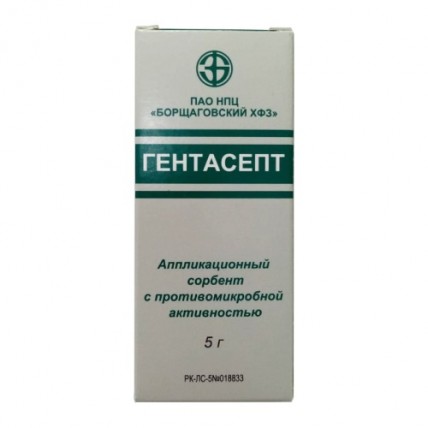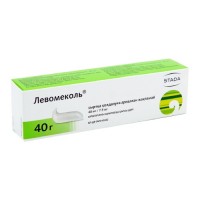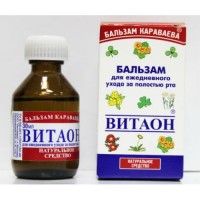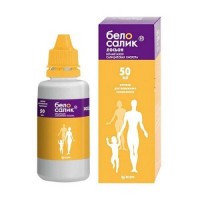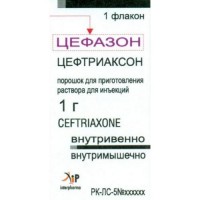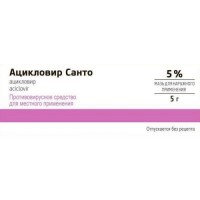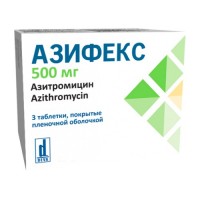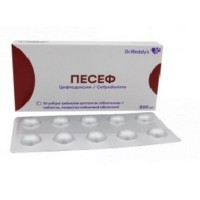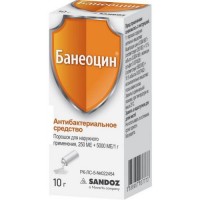GENTASEPT (Gentamicin) powder, 5 g
- $28.00
Gentasept has a prolonged antimicrobial and sorption-detoxification effect; reduces manifestations of local and general intoxication, normalizes microcirculation, gas exchange, pH of the environment in the wound.
Gentasept also cleanses burn wounds, reduces inflammatory reactions, etc. It is recommended to apply topically through a dropper.
1 g of the drug contains active ingredients:
Pharmacokinetics have not been studied, since Gentasept is a non-systemic drug, acts only superficially and does not have a resorptive effect.
Gentasept is a combined preparation for topical use, which contains an aminoglycoside of gentamicin sulfate, an organic silicon sorbent - polymethylsiloxane (methoxane) and a zinc compound with tryptophan. Gentamicin sulfate is a broad-spectrum antibiotic with a bactericidal effect, active against pathogenic gram-positive microorganisms - Staphylococcus aureus, streptococcus, Mycobacterium spp. and gram-negative microorganisms - Pseudomonas aeruginosa, Aerobacter aeruginosa, Escherichia coli, Proteus spp., Klebsiella spp., Serratia spp., Shigella spp., Salmonella spp., Citrobacter spp., Providenta spp., Yerinia spp. Polymethylsiloxane provides sorption and detoxification properties and, together with zinc and tryptophan, potentiates the antibacterial effect and maintains the antimicrobial concentration of the antibiotic in the wound. Application therapy with gentasept reduces the number of microorganisms in the wound by 2–3 days, accelerates the transition from the hydration phase to the dehydration phase, and prevents the development of possible purulent-septic complications. Due to its sorption properties, the drug absorbs toxic waste products of microorganisms, low-molecular toxic tissue metabolites (pyruvic and lactic acids, peroxide compounds, amino acid oxidation products, polypeptides, lipids, etc.), fibrin dehydration products. The drug gentasept, due to its constituent gentamicin, inhibits protein synthesis of microorganisms, preventing the formation of a complex of transport and messenger RNA, disrupts the barrier function of the cytoplasmic membrane and causes the death of microorganisms. Gentasept reduces the manifestations of local (does not have a resorptive effect) intoxication due to antibacterial properties, draining and anti-edematous action, normalization of microcirculation, gas exchange, pH of the environment in the wound. This contributes to the cleansing of the wound from the products of exudation and tissue decay, the disappearance of local inflammatory reactions, as a result of which the growth of granulation tissue is stimulated, the healing process improves, and the formation of keloid scars is prevented. Gentasept also cleanses burn wounds, reduces inflammatory reactions during their treatment, accelerates the formation of a granulation cover in deep burns and epithelization in superficial burns, and contributes to the qualitative preparation of wounds for autodermoplasty.
Treatment of wounds infected with pathogens sensitive to the drug:
- infected surgical wounds (postoperative suppuration, phlegmon, abscesses)
-traumatic infected wounds of different localization and genesis
- trophic ulcers that occur against the background of chronic venous insufficiency, obliterating atherosclerosis, thrombophlebitis of the superficial veins of the lower extremities
- burns II and III A-III B degrees
- different forms of erysipelas
- bedsores
- wounds in patients with various diseases in which regenerative processes are reduced (diabetes mellitus, immunodeficiency, radiation injury)
-complex prevention of sepsis in case of extensive purulent processes
- prevention of the formation of keloid scars due to faster cleansing of the wound from the products of exudation and tissue breakdown, improving the healing process
Dosage and administration
Gentasept is applied topically.
In the initial stage (1-5 days), the dressings are changed 1-2 times a day, after a decrease in inflammatory processes, cleansing the wound of purulent-necrotic masses, the appearance of granulation and epithelialization of the wound - 1 time within 1-2 days.
Gentasept is applied to the surface of the wound through a stopper-dropper (hole in the stopper), removing the cover, after careful surgical treatment, washing the wound with antiseptic solutions with mandatory subsequent drying, so that it covers the surface with a uniform layer (0.5-1 mm) wounds.
With extensive lesions, for example, with burns, one-time use of 8-12 g of the drug is possible. After applying gentasept, the wound is drained according to the general rules and a bandage is applied.
With widespread wound tissue defects, loose packing with gauze napkins is allowed.
For the treatment of burns, gentasept is applied to the burn surface both in the first 5-6 days and during the sequestration of the burn eschar (up to 15 days). In this case, the drug is fixed on the wound with the help of an aseptic bandage.
In cases where the surgical treatment of the wound cannot be performed in full, the wound is covered with gentasept at a dose of 0.5-4 g, depending on the area of the lesion, and a bandage is applied, but not more than 24 hours.
Children
Gentasept can be used in the treatment of children of all age categories, since it is a non-systemic drug, it acts only superficially and does not have a resorptive effect.
Side effects
- allergic reactions (urticaria, contact dermatitis, itching, erythema)
Contraindications
- hypersensitivity to gentamicin sulfate and other components that make up the drug
Drug Interactions
The interaction of the drug Gentasept with other drugs has not been studied. It is possible to enhance the action when used locally with antibiotics that have a bactericidal effect.
Gentasept can be applied to the surface of wounds only after careful surgical treatment. The drug prevents sticking of dressings and the appearance of pain when they are removed.
When applied topically, the drug does not have a local irritating effect, but gentasept should not be allowed to get into the eyes.
Prolonged use of the drug may lead to overgrowth of non-susceptible microorganisms. With the development of irritation, sensitization or superinfection against the background of the use of the drug, treatment should be discontinued and appropriate therapy prescribed.
Pregnancy and lactation
There are no data on the use of the drug during pregnancy or lactation. If it is necessary to use the drug Gentasept during pregnancy or during lactation, the doctor should give recommendations on the appropriateness of its use, taking into account the benefit / risk ratio.
Features of the influence of the drug on the ability to drive a vehicle or potentially dangerous mechanisms
Does not affect.
Overdose
Symptoms: urticaria, contact dermatitis, itching.
Treatment: drug withdrawal; conducting desensitizing therapy.
Store in original packaging at a temperature not exceeding 25 °C.
Keep out of the reach of children!
Shelf life - 4 years
Do not use after the expiration date.
Gentasept also cleanses burn wounds, reduces inflammatory reactions, etc. It is recommended to apply topically through a dropper.
Composition
1 g of the drug contains active ingredients:
- Gentamycin sulfate in terms of gentamicin and anhydrous substance 0.024 g
- L-Tryptophan 0.014 g
- Zinc sulfate heptahydrate 0.010 g
- Methoxane is sufficient to obtain 1 g.
Pharmacological properties
Pharmacokinetics
Pharmacokinetics have not been studied, since Gentasept is a non-systemic drug, acts only superficially and does not have a resorptive effect.
Pharmacodynamics
Gentasept is a combined preparation for topical use, which contains an aminoglycoside of gentamicin sulfate, an organic silicon sorbent - polymethylsiloxane (methoxane) and a zinc compound with tryptophan. Gentamicin sulfate is a broad-spectrum antibiotic with a bactericidal effect, active against pathogenic gram-positive microorganisms - Staphylococcus aureus, streptococcus, Mycobacterium spp. and gram-negative microorganisms - Pseudomonas aeruginosa, Aerobacter aeruginosa, Escherichia coli, Proteus spp., Klebsiella spp., Serratia spp., Shigella spp., Salmonella spp., Citrobacter spp., Providenta spp., Yerinia spp. Polymethylsiloxane provides sorption and detoxification properties and, together with zinc and tryptophan, potentiates the antibacterial effect and maintains the antimicrobial concentration of the antibiotic in the wound. Application therapy with gentasept reduces the number of microorganisms in the wound by 2–3 days, accelerates the transition from the hydration phase to the dehydration phase, and prevents the development of possible purulent-septic complications. Due to its sorption properties, the drug absorbs toxic waste products of microorganisms, low-molecular toxic tissue metabolites (pyruvic and lactic acids, peroxide compounds, amino acid oxidation products, polypeptides, lipids, etc.), fibrin dehydration products. The drug gentasept, due to its constituent gentamicin, inhibits protein synthesis of microorganisms, preventing the formation of a complex of transport and messenger RNA, disrupts the barrier function of the cytoplasmic membrane and causes the death of microorganisms. Gentasept reduces the manifestations of local (does not have a resorptive effect) intoxication due to antibacterial properties, draining and anti-edematous action, normalization of microcirculation, gas exchange, pH of the environment in the wound. This contributes to the cleansing of the wound from the products of exudation and tissue decay, the disappearance of local inflammatory reactions, as a result of which the growth of granulation tissue is stimulated, the healing process improves, and the formation of keloid scars is prevented. Gentasept also cleanses burn wounds, reduces inflammatory reactions during their treatment, accelerates the formation of a granulation cover in deep burns and epithelization in superficial burns, and contributes to the qualitative preparation of wounds for autodermoplasty.
Indications for use
Treatment of wounds infected with pathogens sensitive to the drug:
- infected surgical wounds (postoperative suppuration, phlegmon, abscesses)
-traumatic infected wounds of different localization and genesis
- trophic ulcers that occur against the background of chronic venous insufficiency, obliterating atherosclerosis, thrombophlebitis of the superficial veins of the lower extremities
- burns II and III A-III B degrees
- different forms of erysipelas
- bedsores
- wounds in patients with various diseases in which regenerative processes are reduced (diabetes mellitus, immunodeficiency, radiation injury)
-complex prevention of sepsis in case of extensive purulent processes
- prevention of the formation of keloid scars due to faster cleansing of the wound from the products of exudation and tissue breakdown, improving the healing process
Dosage and administration
Gentasept is applied topically.
In the initial stage (1-5 days), the dressings are changed 1-2 times a day, after a decrease in inflammatory processes, cleansing the wound of purulent-necrotic masses, the appearance of granulation and epithelialization of the wound - 1 time within 1-2 days.
Gentasept is applied to the surface of the wound through a stopper-dropper (hole in the stopper), removing the cover, after careful surgical treatment, washing the wound with antiseptic solutions with mandatory subsequent drying, so that it covers the surface with a uniform layer (0.5-1 mm) wounds.
With extensive lesions, for example, with burns, one-time use of 8-12 g of the drug is possible. After applying gentasept, the wound is drained according to the general rules and a bandage is applied.
With widespread wound tissue defects, loose packing with gauze napkins is allowed.
For the treatment of burns, gentasept is applied to the burn surface both in the first 5-6 days and during the sequestration of the burn eschar (up to 15 days). In this case, the drug is fixed on the wound with the help of an aseptic bandage.
In cases where the surgical treatment of the wound cannot be performed in full, the wound is covered with gentasept at a dose of 0.5-4 g, depending on the area of the lesion, and a bandage is applied, but not more than 24 hours.
Children
Gentasept can be used in the treatment of children of all age categories, since it is a non-systemic drug, it acts only superficially and does not have a resorptive effect.
Side effects
- allergic reactions (urticaria, contact dermatitis, itching, erythema)
Contraindications
- hypersensitivity to gentamicin sulfate and other components that make up the drug
Drug Interactions
The interaction of the drug Gentasept with other drugs has not been studied. It is possible to enhance the action when used locally with antibiotics that have a bactericidal effect.
Special instructions
Gentasept can be applied to the surface of wounds only after careful surgical treatment. The drug prevents sticking of dressings and the appearance of pain when they are removed.
When applied topically, the drug does not have a local irritating effect, but gentasept should not be allowed to get into the eyes.
Prolonged use of the drug may lead to overgrowth of non-susceptible microorganisms. With the development of irritation, sensitization or superinfection against the background of the use of the drug, treatment should be discontinued and appropriate therapy prescribed.
Pregnancy and lactation
There are no data on the use of the drug during pregnancy or lactation. If it is necessary to use the drug Gentasept during pregnancy or during lactation, the doctor should give recommendations on the appropriateness of its use, taking into account the benefit / risk ratio.
Features of the influence of the drug on the ability to drive a vehicle or potentially dangerous mechanisms
Does not affect.
Overdose
Symptoms: urticaria, contact dermatitis, itching.
Treatment: drug withdrawal; conducting desensitizing therapy.
Storage conditions
Store in original packaging at a temperature not exceeding 25 °C.
Keep out of the reach of children!
Shelf life - 4 years
Do not use after the expiration date.
